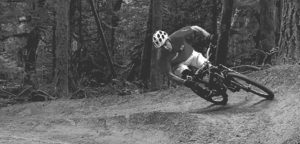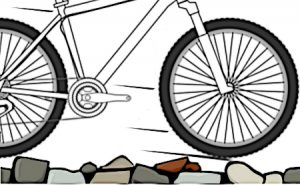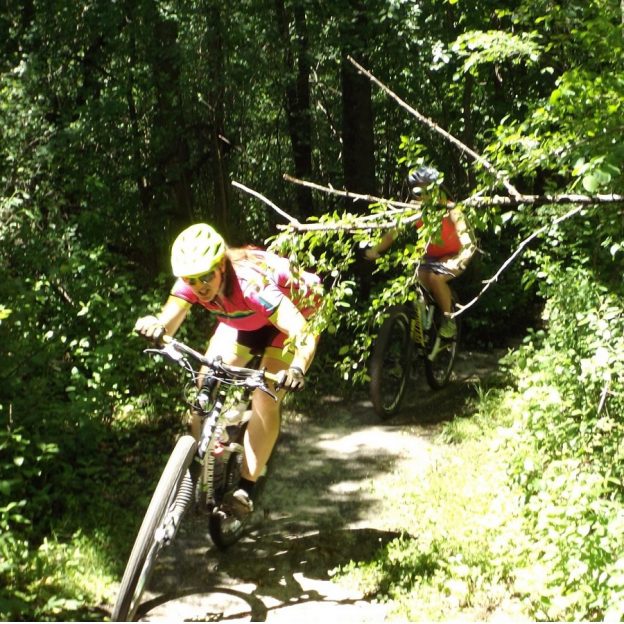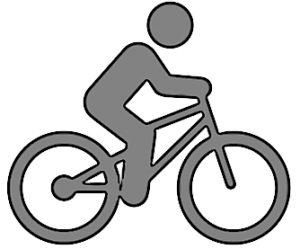John Brown, HaveFunBiking
Starting a new sport like Mountain Biking is a ton of fun. The experience of exploring local trails and challenging obstacles is exhilarating. Here are a few tips to get you riding faster and smoother.
Mountain Biking Tip 1 – Hips Don’t Lie
Want to make your bike turn? Simple, just turn the handlebars, right?! Well….not exactly. Contrary to popular belief you don’t really steer with the handlebars when mountain biking as much as you think. Your bike turns when you shift your center of gravity (hips). If you want proof, try this basic test next time you’re on your bike. Ride along a piece of smooth flat ground and push gently on your right grip. Pushing on the right grip will turn the front wheel to the left, and theoretically, the bike will turn left. What will actually happen is that your bike will jerk to the right. How can this be? Well, when you push on the right grip, your center of gravity shifts to the right, and your bike follows. So next time you ride, try and keep your hips centered over the bike for stability, and when turning, shift them in the direction you want to go.

This riders hips are pointed in the direction of the turn
Mountain Biking Tip 2 – Knees In
Mountain biking successfully is all about traction. As the trail changes material, density, and direction, you are in the constant pursuit of traction. Losing traction in a turn is dangerous but mostly avoidable. To maximize the traction you do have, First, turn your hips into the turn like stated above, then also lower your outside foot and turn both knees into the turn. By doing this, you are lowering your center of gravity (giving you more stability) and adding force to the area of your tire that is doing the gripping. Testing this one is easy and FUN! Pick a corner you can comfortably take with some speed ride through it with you feet level and hips on the pushed to the outside of the turn. Then take the same turn with your outside foot down, and hips and knees pointed to the inside of the turn (on your outside leg, the inner surface of your hip may rest on the top tube. That’s OK). you should feel the difference in traction immediately.
Mountain Biking Tip 3 – Be Shocking
Most mountain bikes are equipped with suspension to absorb impact and maintain stability. That suspension can handle rocks, logs or bumps smaller than your fist. While suspension does a great job of taking the edge off, most trails consist of larger objects. Your legs and arms can be your suspension once things get rougher. Keep a good bend to your elbows and knees, get off your saddle, and be the shock. You will find that with some motion on your part, your bike can start handling objects taller than a water bottle with ease.
Go Straight Really Fast, and if Something Gets in Your Way……….Turn
Sounds simple, but it’s the truth. Speed naturally helps with stability. As wheels get up to speed, they naturally want to stay upright. You will also find that the faster you go the trail will feel smother. This is from the bikes tires skipping over the tops of objects, rather than dipping into every valley between them. Once at speed, try to keep your bars facing the direction you want to go and your hips centered. If the front wheel is always facing the direction of movement, its’s easier to maintain speed and stability. Speed does have its consequences as well. Always ride within your abilities.

With more speed, tires begin skipping over the high points of the trail
Ride Within Your Ability, but Experiment
When you go mountain biking with others, there can be pressure to ride everything others ride. If a trail is filled with obstacles above your skill level, walk it. You may also want to attempt the first part only. Once you master that first obstacle, try the second, and so on. Breaking challenging trail sections into smaller parts, mastering each separately, then trying to connect everything is a great way to build confidence and stay safe.
By using these tips you should feel comfortable in time, exploring all the trails you area has to offer. Remember to start small and progress as you feel comfortable and follow the rules of the trail. If you liked this information, check out our riding hacks for road bikes as well.


